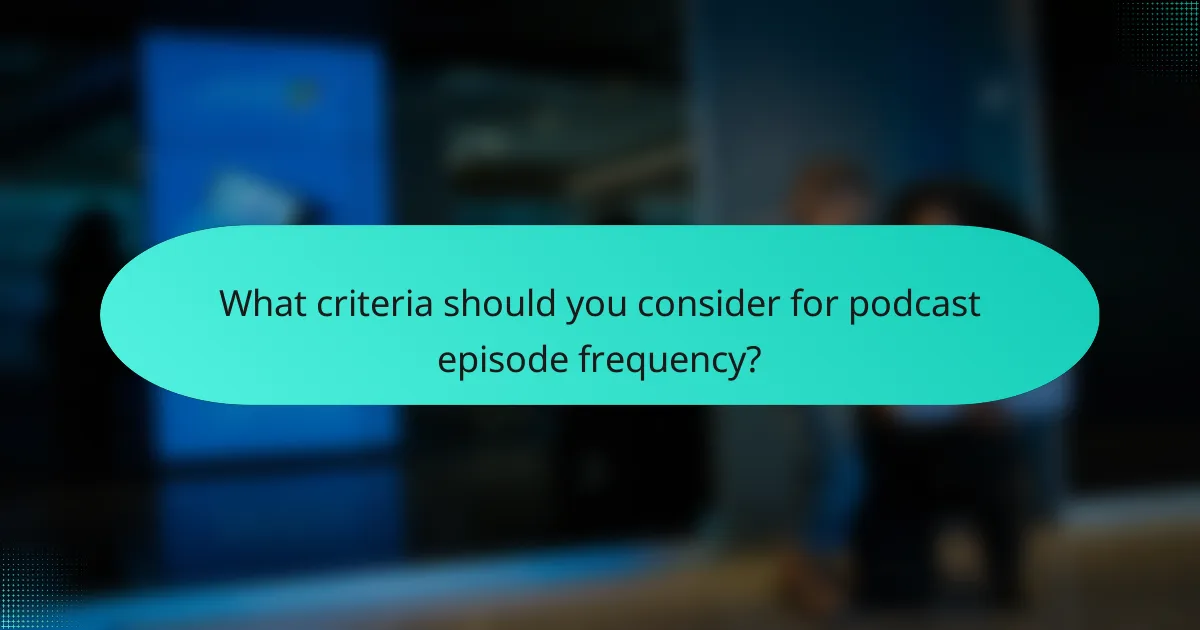In the UK podcasting landscape, the frequency of episode releases plays a vital role in maintaining audience engagement and ensuring content depth. By strategically selecting between weekly, bi-weekly, or monthly schedules, creators can align their output with their thematic goals. Additionally, incorporating diverse guests enriches the narrative, offering a broader spectrum of ideas and experiences that resonate with listeners. Striking a balance between in-depth discussions and accessible topics is essential for appealing to a wide audience.

How often should you release podcast episodes in the UK?
In the UK, the frequency of podcast episode releases can significantly impact audience engagement and content depth. Generally, you can choose between weekly, bi-weekly, or monthly releases based on your goals and the nature of your topics.
Weekly releases for audience engagement
Releasing episodes weekly can help maintain strong audience engagement and build a loyal listener base. This frequency allows you to keep your content fresh and relevant, encouraging listeners to return regularly.
Consider creating a consistent schedule, such as every Monday, to establish a routine for your audience. However, ensure that you have enough quality content to sustain this pace without sacrificing depth.
Bi-weekly for in-depth content
Bi-weekly releases offer a balance between frequency and depth, allowing you to explore topics more thoroughly. This schedule gives you ample time to research, script, and produce high-quality episodes that resonate with your audience.
For example, if your podcast covers complex subjects, a bi-weekly format can facilitate deeper discussions and interviews, enhancing the overall value of your content. This approach can also reduce burnout for creators.
Monthly for niche topics
Monthly releases are ideal for niche topics that require extensive research or specialized knowledge. This frequency allows you to delve deeply into subjects that may not have broad appeal but are highly relevant to a specific audience.
When opting for a monthly schedule, consider supplementing your main episodes with shorter content, such as updates or Q&A sessions, to keep your audience engaged between releases. This strategy can help maintain interest while ensuring your main episodes are well-crafted and informative.

What is the importance of guest diversity in UK podcasts?
Guest diversity in UK podcasts is crucial as it enriches content and broadens audience appeal. By featuring guests from various backgrounds, podcasts can present a wider range of ideas and experiences, making the content more engaging and relatable.
Enhances content richness
Diverse guests contribute unique insights and stories, which enhance the overall richness of podcast content. For instance, a podcast discussing social issues can benefit from guests with different cultural perspectives, leading to deeper discussions and more nuanced understanding.
Incorporating a variety of voices can also introduce listeners to topics they may not have considered, fostering a more comprehensive exploration of subjects. This approach can keep the content fresh and interesting, encouraging repeat listens.
Attracts wider audience demographics
Featuring a diverse array of guests helps attract a broader audience demographic. Different guests resonate with different listener groups, which can significantly expand the podcast’s reach. For example, a podcast that includes guests from various age groups, ethnicities, and professions can appeal to listeners from those backgrounds.
This strategy not only increases listener numbers but also enhances community engagement, as more people feel represented and included in the conversation. Podcasts that prioritize diversity often see a more loyal and varied audience base.
Encourages varied perspectives
Diverse guests bring varied perspectives that can challenge prevailing narratives and stimulate critical thinking. This is particularly important in a landscape where many topics are often viewed through a narrow lens. By presenting multiple viewpoints, podcasts can foster open dialogue and encourage listeners to consider alternative opinions.
Additionally, this diversity can lead to more innovative ideas and solutions, as different experiences can inspire creative thinking. Podcasts that embrace varied perspectives are more likely to spark meaningful conversations and inspire action among their audience.

How deep should podcast topics be for UK listeners?
Podcast topics for UK listeners should strike a balance between depth and accessibility. While some audiences appreciate detailed explorations, others prefer lighter content that is easy to digest.
In-depth analysis for expert audiences
For expert audiences, podcasts should delve deeply into specific subjects, offering comprehensive insights and data. This could include detailed case studies, expert interviews, and thorough examinations of trends. Such depth not only satisfies the curiosity of knowledgeable listeners but also establishes the podcast as a credible source in its niche.
Consider including technical jargon and industry-specific terminology, as these listeners often appreciate the challenge of complex discussions. However, ensure that the content remains engaging and avoids becoming overly dense or inaccessible.
Surface-level discussions for casual listeners
Casual listeners typically prefer surface-level discussions that are easy to follow and entertaining. These podcasts should focus on broad themes, relatable anecdotes, and general insights rather than intricate details. This format allows for a more relaxed listening experience, making it suitable for everyday activities like commuting or exercising.
To cater to this audience, consider using storytelling techniques and humor to keep the content engaging. Avoid heavy jargon and complex theories, as these may alienate listeners who are not deeply familiar with the subject matter.
Balanced approach for general appeal
A balanced approach combines elements of both in-depth analysis and surface-level discussions, appealing to a wider audience. This can be achieved by introducing a topic with a general overview before diving into more detailed segments. This method allows listeners of varying expertise to engage with the content at their own level.
In practice, consider structuring episodes with a clear outline that includes both foundational information and deeper insights. This way, you can cater to both casual listeners and those seeking more substantial content, ensuring that your podcast remains inclusive and informative.

What criteria should you consider for podcast episode frequency?
When determining podcast episode frequency, consider your audience’s preferences, your production capacity, and the competitive landscape. Striking a balance between consistent content delivery and quality is essential for maintaining listener engagement.
Audience feedback and preferences
Understanding your audience’s feedback is crucial for deciding how often to release episodes. Conduct surveys or monitor social media interactions to gauge their preferences for frequency, which can range from weekly to monthly releases. Engaging with your listeners can help you tailor your schedule to meet their expectations.
Consider creating a poll to ask your audience directly about their preferred episode frequency. This can provide valuable insights and foster a sense of community, making listeners feel more invested in your podcast.
Content production capacity
Your ability to produce high-quality content consistently is a key factor in determining episode frequency. Assess your resources, including time, equipment, and team size, to establish a realistic schedule. For instance, if you have a small team, a bi-weekly release might be more manageable than a weekly one.
Establishing a content calendar can help you plan ahead and avoid burnout. This allows you to allocate time for research, recording, and editing, ensuring that each episode meets your quality standards.
Market trends and competition
Keeping an eye on market trends and your competitors can inform your podcast episode frequency. If similar podcasts in your niche are releasing episodes weekly, you may want to match that cadence to stay relevant. However, if they focus on quantity over quality, consider a less frequent schedule that emphasizes depth and value.
Analyze successful podcasts to identify patterns in their release schedules. This can help you find a unique position in the market, whether that means offering more in-depth content less frequently or aligning with industry trends to capture audience interest.

How can you ensure guest diversity in your podcast?
To ensure guest diversity in your podcast, actively seek out individuals from various backgrounds, experiences, and perspectives. This approach not only enriches your content but also resonates with a broader audience.
Research diverse industry leaders
Start by identifying leaders in your industry who come from different demographics, including gender, ethnicity, and professional backgrounds. Look for organizations or networks that promote diversity, as they often have lists or directories of potential guests.
Consider reaching out to universities, community organizations, or professional associations that focus on underrepresented groups. Engaging with these entities can provide valuable insights and connections to diverse voices.
Utilize social media for outreach
Social media platforms are powerful tools for discovering and connecting with diverse guests. Use hashtags related to diversity and inclusion to find individuals who actively discuss these topics. Platforms like Twitter and LinkedIn can be particularly useful for identifying thought leaders.
When reaching out, personalize your messages to express genuine interest in their work and how it aligns with your podcast’s themes. Be clear about the value they would bring to your audience and the importance of their unique perspective.
